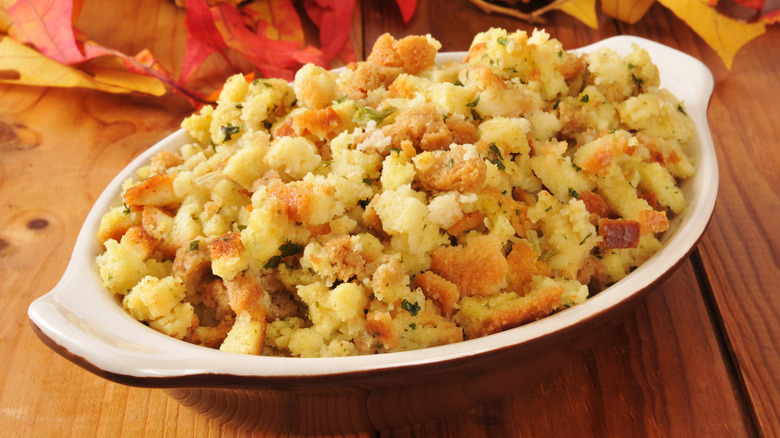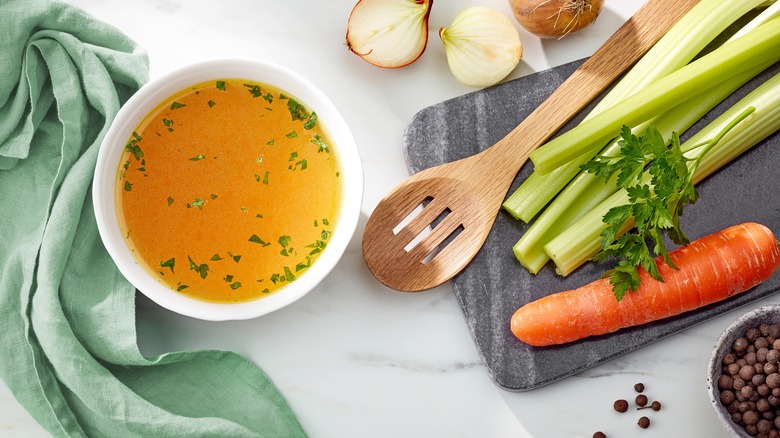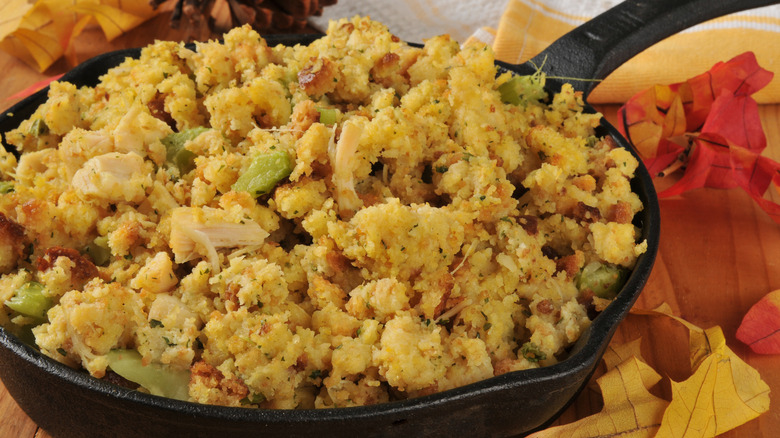The Seasoning Mistake You Need To Avoid When Making Cornbread Dressing
While cornbread dressing may be a side dish, its flavor should still stand out on the plate and entice people to consider a second helping. Even though fresh, sweet corn may require only a small pat of butter, cornbread dressing benefits from added seasoning. However, that added flavor should not overshadow the primary taste of the dish: the cornbread itself.
Although the contrast between sweet and savory can be delightful, the biggest seasoning mistake in cornbread dressing is using a store-bought option that contains too much sugar. Even if buying pre-made cornbread is more convenient than baking it from scratch, a sugary stuffing is generally not what people expect in this side dish. Using a pre-made ingredient means you lose control over the initial flavor profile. While this issue can be avoided by baking unsweetened cornbread from scratch, another option is to balance out the sweetness with other ingredients.
If you're using store-bought or pre-made cornbread as the base for your stuffing, consider countering any excessive sweetness by adding salt and other seasonings to achieve balance. A dash of cayenne pepper or a sprinkle of sage can mitigate the sweetness. Nonetheless, finding an overall balance in the recipe is crucial. Much like a flat note in a melody, an off-putting flavor can stand out — and not in a good way. For a more satisfying cornbread stuffing, consider saving that spoonful of sugar for the dessert course.
Be mindful of the stock you use
While dried or slightly stale cornbread may be the starting point for your dressing recipe, nobody wants crunchy toast served in their casserole dish. The liquid you choose to add to the cornbread not only mitigates the crunchy texture but also enhances the overall flavor of the dish.
Similar to the seasoning issues with store-bought cornbread, store-bought stock can contain unwanted additives that throw off the dish's seasoning balance. Randomly grabbing a can off the shelf is not advisable. Variations like "no added salt," "low sodium," and even the type of stock itself can affect the dish's overall flavor. For example, a salty stock may require adjustments to other ingredients. You wouldn't want your guests chugging water because the dish tastes like a salt lick. It might be smarter to opt for a no-sodium-added or lower-salt store-bought stock to better control the dish's salt content.
For those who prefer using homemade stock, the same principles apply. Making a dish from scratch allows for more control over seasoning levels, but ingredients should not be added to the pot haphazardly. A sprinkle here and a dash there might sound whimsical, but tasting and re-tasting can ensure that the dish's flavor is well-calibrated rather than a matter of guesswork.
Fresh or dried herbs in cornbread dressing
While cornbread is the star of the dish, it wouldn't shine without its supporting cast of ingredients. Herbs and other aromatics season each bite. Though scene-stealers like chorizo and peppers may offer bold flavor notes, the overall bite should be harmonious.
Aromatics, such as mirepoix, often serve as the starting point. The aroma of onions sweating in the pan is not just enticing; it builds flavor. While some people may prefer no crunchy bits in the mix, cooking the onions and other vegetables brings out their caramelized and unctuous qualities. Moreover, the softer texture eliminates any jarring contrast with the tender cornbread.
Care is also required when building flavor with herbs. Just as raw, crunchy onion can be unappealing, so can whole herbs that stand out in an unpleasant way. Remember to finely chiffonade herbs or remove whole bay leaves before serving. Although fresh or dried herbs help create layers of flavor, no one wants the cornbread to be overpowered by the garden.
In the end, avoiding significant seasoning mistakes in your cornbread stuffing recipe is entirely manageable. "Taste, season, and taste again" might be the best mantra to remember in the kitchen.


